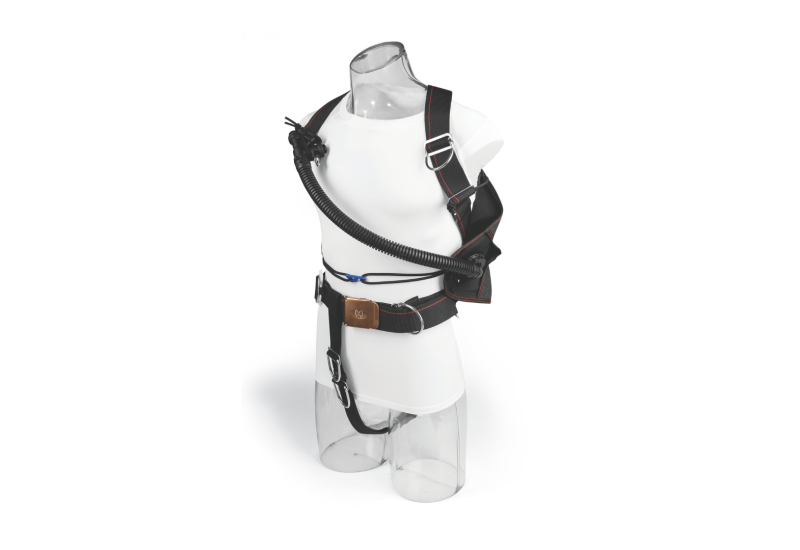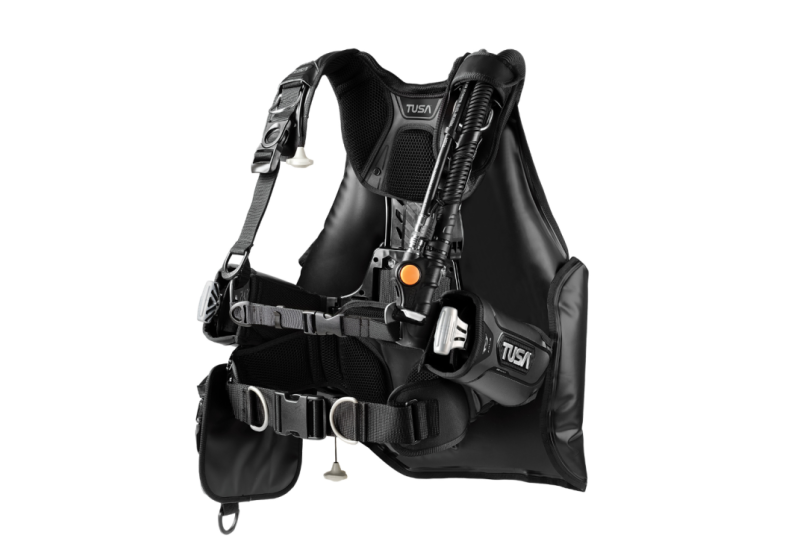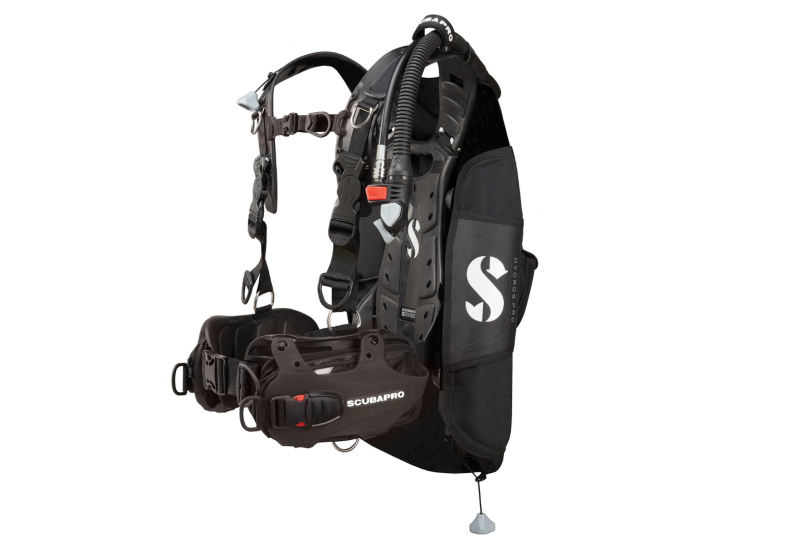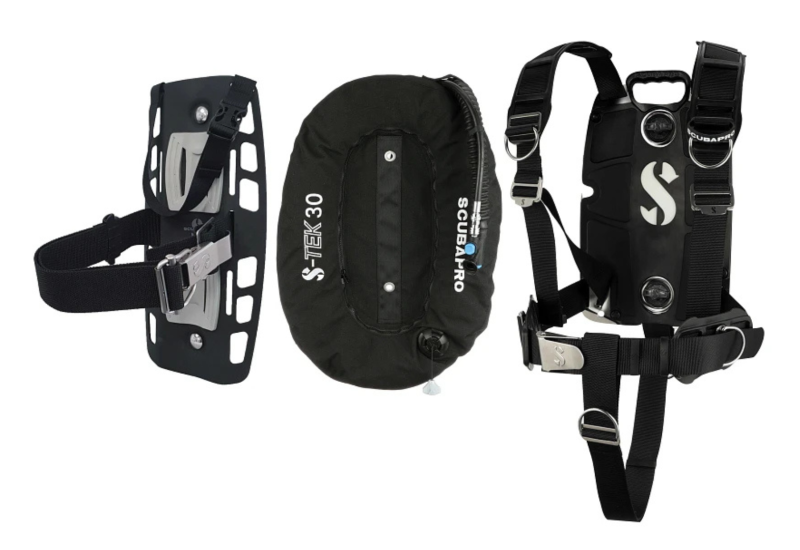The Best Scuba Diving Regs, BCs, Fins, Knives and Snorkels on the Market
This past year ScubaLab tested more than 70 pieces of new gear. Here are the regs, BCs, fins, snorkels and knives that excelled.
GEAR OF THE YEAR: REGS
With so many regs to test in 2015, we split up our test, evaluating models under $500 (July) and over $500 (August).
How We Test Regulators
ScubaLab put these regs through two tests — the first is conducted on a breathing simulator (objective), and the second by our team of test divers (ergonomic).
Objective Testing
We conducted tests on an ANSTI wet breathing simulator at Dive Lab, a commercial test facility in Panama City Beach, Florida. The simulator measures the effort (work of breathing) required to move air through a regulator as it is subjected, under- water, to a precise series of depths and breathing rates.
The simulator pressurizes the test chamber to simulate depths of 132 fsw, 165 fsw and 198 fsw. Each “breath” by the machine moves 2.5 liters of air through the regulator, at breathing rates of 15, 25 and 30 breaths a minute. These precisely measured volumes of air — 2.5 liters multiplied by the breathing rate — are called Respiratory Minute Volumes (RMVs).
We don’t test on the simulator for a pass/fail grade, but to objectively gauge performance in carefully controlled conditions. You can see how each reg performed on the breathing simulator in the charts that accompany the reviews.
Ergonomic Test Categories
-
Ease of breathing in swimming position
-
Ease of breathing in head-up position
-
Ease of breathing in head-down position
-
Wetness in normal swimming position
-
Wetness in head-down and odd positions
-
Bubble interference in normal swimming position
-
Bubble interference in vertical/stationary position
-
Ease of clearing regulator using the blowing method
-
Ease of clearing regulator using the purge button
-
Purge button stiffness and comfort
-
Comfort of mouthpiece
-
Venturi lever adjustment function and effectiveness
-
Breathing- adjustment-knob function and effectiveness
See the Full Test Results Here
GEAR OF THE YEAR: BCs
In our June issue we tested 13 new jacket, hybrid and back-inflation BCs for performance, stability and comfort.
How We Test BCs
A ScubaLab BC test has two parts: an in-water ergonomic evaluation by test divers and a series of objective tests we perform in a pool.
Ergonomic Test Categories
-
Assembly
-
Loading Weight System
-
Comfort and Adjustment
-
Attitude and Stability
-
Pockets
-
Valve Operation
-
Ascent Control
-
Surface Floating Position
-
Weight-Ditch System
Objective Tests
-
Flow-Rate Test
-
Buoyant Lift Test
-
Inherent Buoyancy Test
See the Full Test Results Here
GEAR OF THE YEAR: FINS
In our May issue we tested 13 new open-heel and full-foot fins in a wide variety of styles and designs.
How We Test Fins
Fins were also evaluated for weight, buoyancy and the effectiveness of non-slip material on the bottom of the sole.
Fin Test Categories
- Ease of Donning Fin
- Adjusting for Fit
- Fit and Comfort
- Stability
- Power vs. Stress
- Kicking Style
- Acceleration
- Maneuverability
- Surface Swimming
- Ease of Removing Fin
See the Full Test Results Here
GEAR OF THE YEAR: SNORKELS
In our September/October issue we tested a dozen snorkels, including pocket models, for performance, comfort and convenience.
How We Test Snorkels
To evaluate the performance of each snorkel in open-water conditions, the ScubaLab team of test divers snorkeled of the beach at Sebastian Inlet State Park on Florida’s Atlantic Coast in seas of about 2 feet, with an onshore breeze of about 12 knots. Using waterproof test sheets and slates, divers rated each snorkel in seven performance categories, with 1 being poor performance and 5 being excellent. Divers also recorded comments about their experience using each snorkel and ranked their top three favorites in each category.
Ergonomic Test Categories
-
Security, adjustability, convenience and ruggedness of the mask attachment.
-
Comfort, water seal and position of the mouthpiece.
-
Effectiveness in blocking water entry.
-
Effectiveness in removing water by the purge valve or blowing.
-
Ability to supply sufficient air.
-
Operating without excessive noise, such as gurgling or rattling.
-
Weight, dimensions, stability (wobbling) or other factors affecting overall comfort.
See the Full Test Results Here
GEAR OF THE YEAR: KNIVES
In our March/April issue we tested 22 knives for performance, construction and corrosion resistance.
How We Test Knives
We evaluated each knife’s ability to cut several types of line:
-
1⁄4-inch diamond braid nylon-poly
-
1⁄4-inch hollow-braid poly
-
1⁄2-inch braided nylon
-
Heavy (.095-inch) plastic trimmer line.
While we could have used tougher lines (such as Kevlar), we chose the lines we did because they’re the kind of cheap, often-discarded, long-lived materials that we encounter diving.
We made a first cut through a hand-held loop of each type of line, and rated the cutting ability from 1 to 5 (1=Poor and 5=Excellent). Next we cut a double thickness of each line, and then we made 20 repetitive cuts of all lines on a block of soft wood, and followed that with more cuts of hand-held loops (since you’re not likely to find a cutting board when diving). We also scored each knife on the following: the security of its sheath or folding/locking mechanism; the ease of deploying/stowing the knife barehanded and with 5 mm gloves; how it withstood 10 pounds of weight when wedged 1-inch deep in a block of wood; and its overall fit and finish.
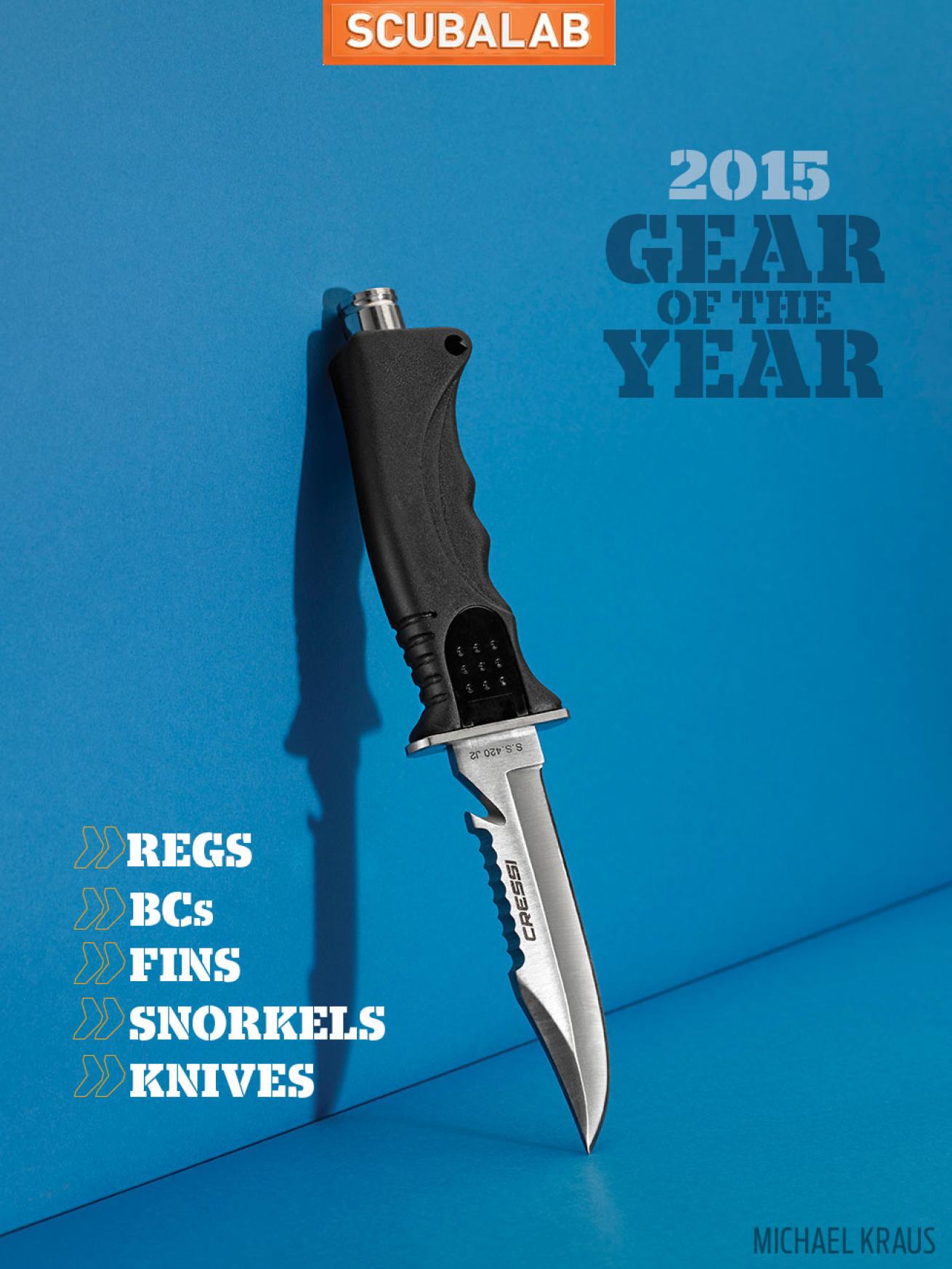
Michael KrausScubaLab Presents the Best of the Best in Dive Gear
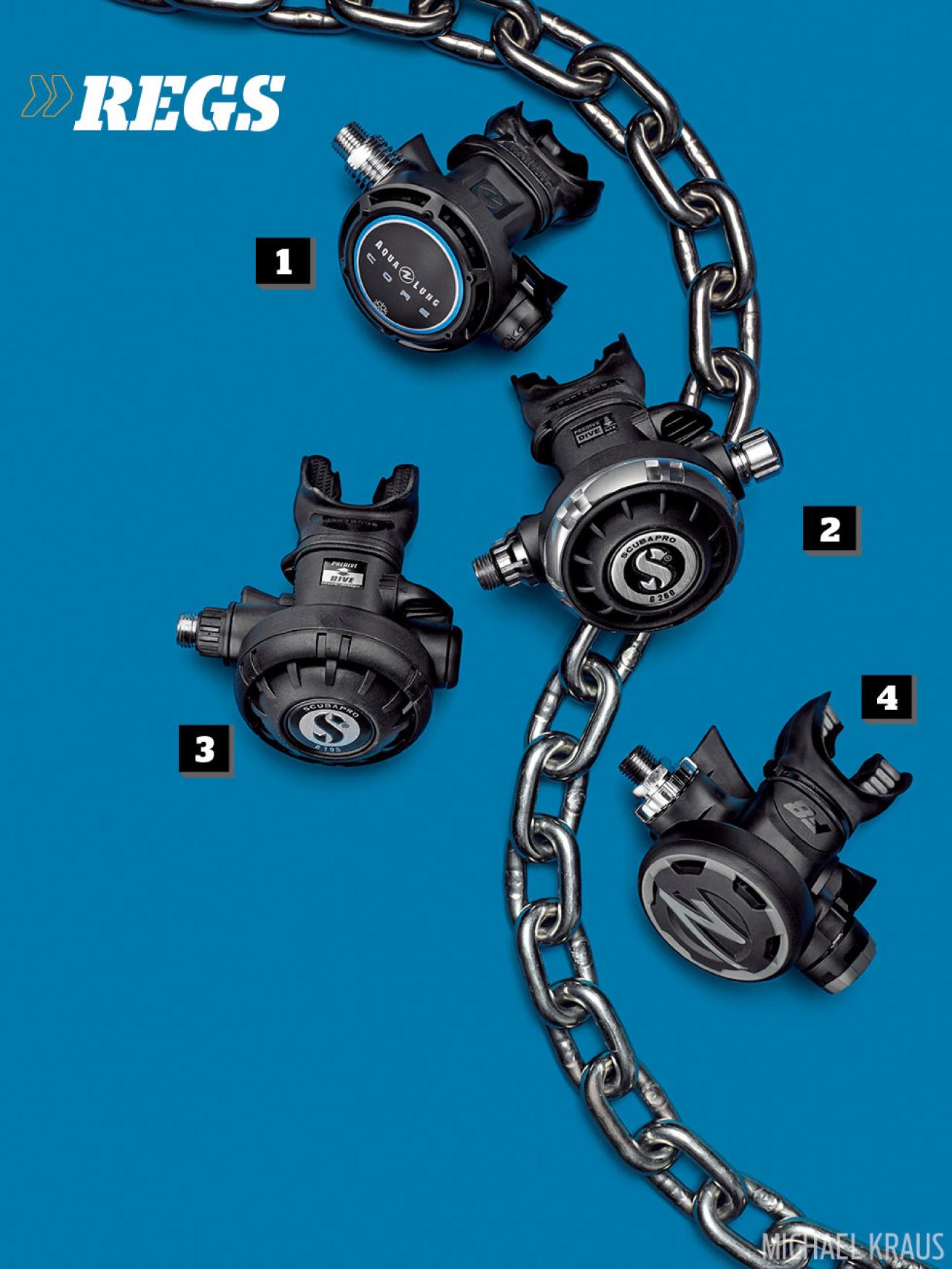
Michael KrausBest Scuba Diving Regulators of 2015
1. BUY: Aqua Lung Core Supreme
Aqua Lung offers the new Core in two versions — regular ($460) and the Supreme, which has an environmentally sealed first stage. Their performance was exceptional. They were the only regs in the under-$500 category to record top marks across the board in tests on the ANSTI breathing simulator. The Core Supreme was our Testers Choice in this category. Contact aqualung.com MSRP $490
2. BUY: ScubaPro MK25 EVO/G260
It’s hard to say what impressed us most about this reg — its performance on the breathing simulator or during ergonomic tests. On the ANSTI simulator it recorded the best work-of-breathing scores of any reg in this year’s test at recreational depth, and it proved a real sweetheart in ergo testing. The MK25 EVO/G260 was our Testers Choice for regs over $500. Contact scubapro.com MSRP $689
It was way back in 1963 that Scubapro debuted the MK2 first stage. It was a game changer then, and many years of upgrades have built on its reputation for performance and reliability. During testing, it delivered impressive performance at the lowest price of any reg in this year’s test, earning it a Best Buy award. Contact scubapro.com MSRP $349
The lightweight F8 has a new design that aims to emphasize comfort as well as performance. In ANSTI simulator testing, the F8 earned excellent work-of-breathing scores not only at recreational depths, but down to our test limits at 198 feet — and at the lowest price of any reg in its category. The Zeagle F8 is our Best Buy for regs over $500. Contact zeagle.com MSRP $599
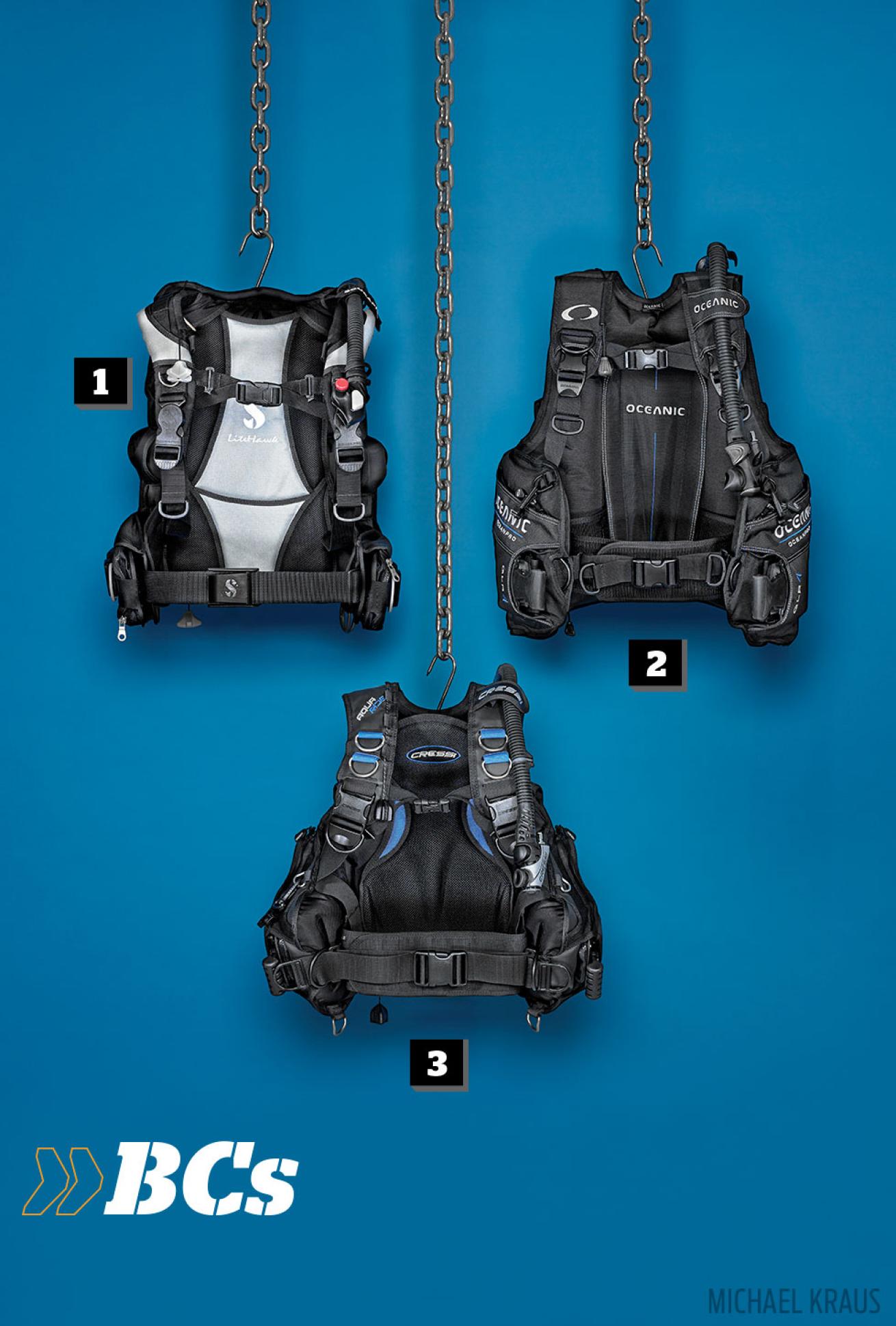
Michael KrausBest Scuba Diving BCs of 2015
Perfect for travelers, the back-inflation Litehawk tips the scales at just over 5 pounds (without integrated weight pockets) and has a back plate that rolls up for packing. Divers found the Litehawk stable in the water, despite its light weight and flexible back plate, thanks to a secure tank-band system and adjustable harness with a belt-style waist strap and a two-position sternum strap. The Litehawk was our Testers Choice in the hybrid/ back-inflation category. Contact scubapro.com MSRP $399 (integrated weight pockets $80)
2. BUY: Oceanic OceanPro The OceanPro is an economy-minded jacket BC, but when it came to performance, test divers found nothing about it that suggested cost shaving. The harness, built around a back plate that’s integrated into the air cell, was rock-solid stable and comfortable. The OceanPro earned the Best Buy award in our test. Contact oceanicworldwide.com MSRP $395 ($439.95 with integrated weights)
3. BUY: Cressi Aquaride Blue Pro Cressi’s latest take on the classic jacket BC — the Aquaride Blue Pro — was the clear winner, taking top scores for valve operation, ascent control, surface floating position and cargo pockets. It’s also neutrally buoyant despite a well- padded and comfortable (and very stable) harness. The Aquaride Blue Pro was our Testers Choice for jacket BCs. Contact cressiusa.com MSRP $479.95
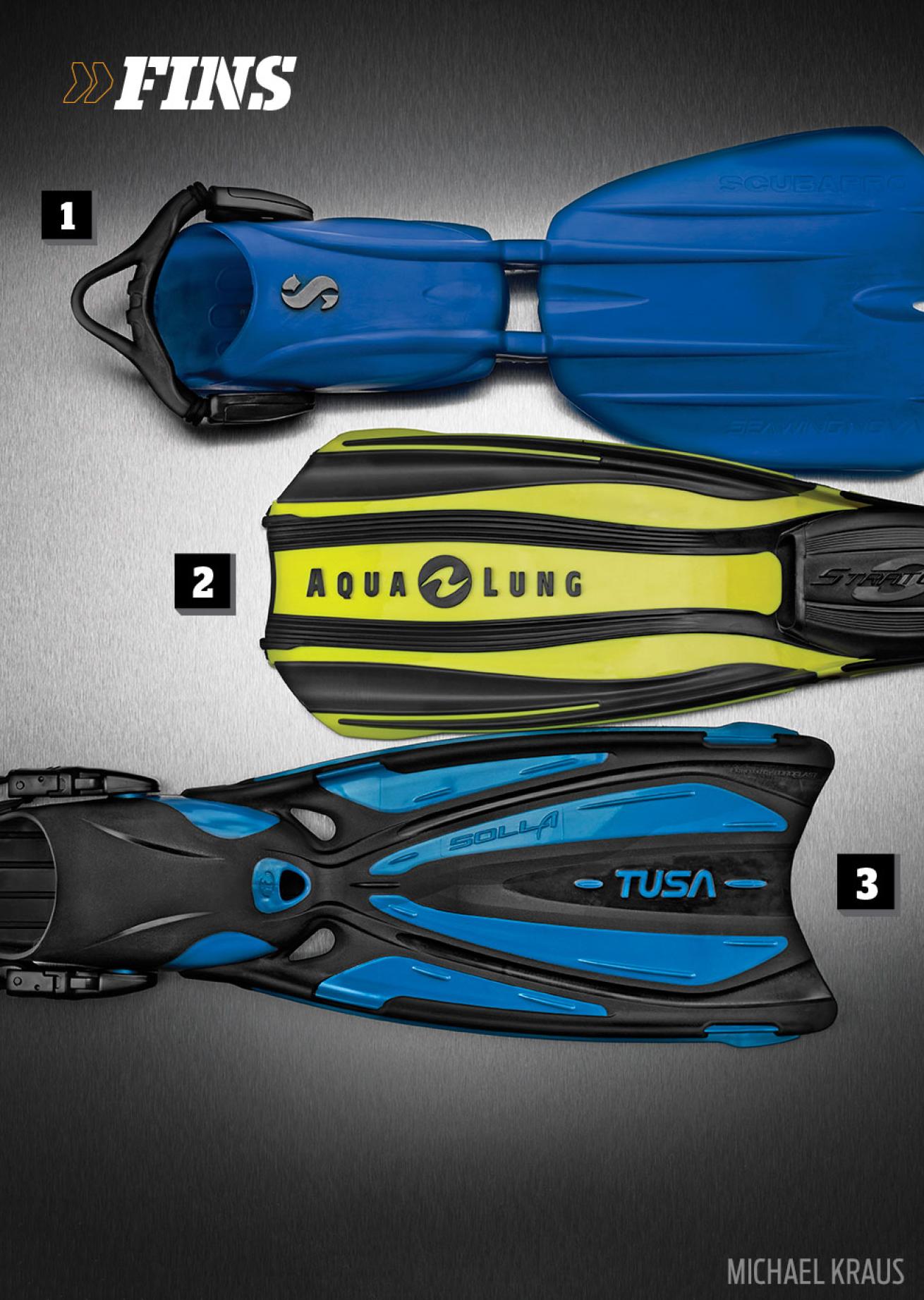
Michael KrausBest Scuba Diving Fins of 2015
1. ScubaPro Seawing Nova II
A perennial favorite, the original Nova took our Testers Choice in 2010, as did the full-foot version in 2013. The Nova II continued its run, earning our 2015 Testers Choice for open-heel fins by virtue of top scores in power versus stress, flutter kick, donning and doffing, and multiple selections as favorite fin in its category. Contact scubapro.com MSRP $199
Outwardly, the Stratos 3 looks like a conventional fin, but the details of its design are the key to its top-notch performance, with a large water-scooping blade. The result is a very noticeable correlation between the effort you put in and the thrust you get. The Stratos 3 was our Testers Choice in full-foot fins. Contact aqualung.com MSRP $80
Lots of new fins combine materials with varying stiffness and flexibility, but the Solla does so to a greater degree — and with greater success — than most, especially across the vented blade and at the junction with the foot pocket. A capable, versatile fin with an affordable price, the Tusa Solla was our Best Buy. Contact tusa.com MSRP $119
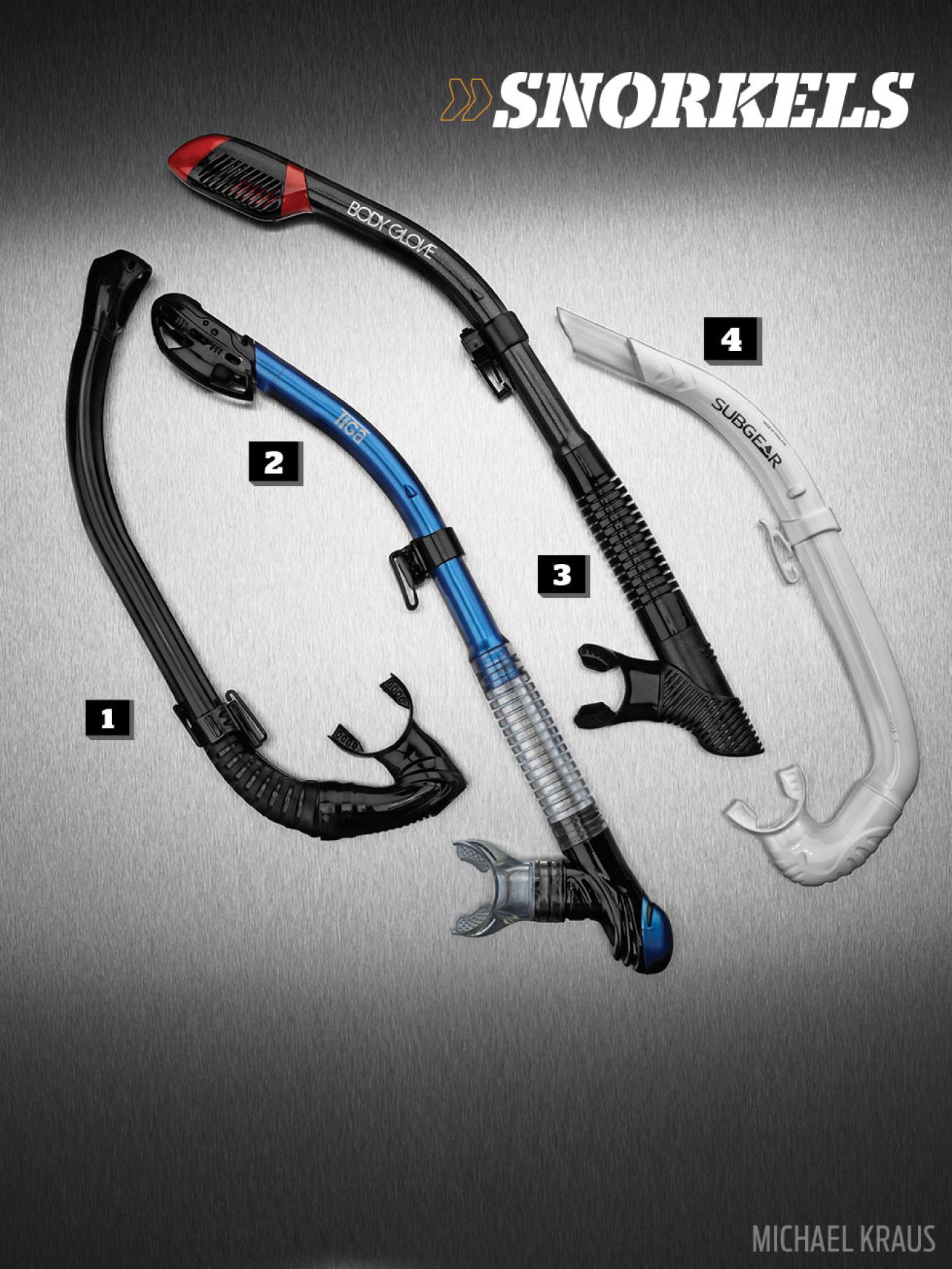
Michael KrausSnorkels ScubaLab 2015 Gear of the Year
Although it’s made of flexible silicone like all the pocket snorkels we tested, the Cargo had several unique features that contributed to its winning performance, including a small but effective purge valve and a semidry top that made it easy for testers to clear water even when using it in choppy water. The Cargo was our Testers Choice in the pocket-snorkel category. Contact xsscuba.com MSRP $33
Several of the dry snorkels in our test did an excellent job keeping out or clearing water, and most had comfortable mouthpieces, streamlined designs and secure mask attachments. Sherwood Scuba’s Tiga combined all of these traits and, as a result, walked away with our Testers Choice award in the dry-snorkel category. Contact sherwoodscuba.com MSRP $46
3. Body Glove Majorca
Unlike the hinged dry-top valves on most of our test snorkels, the Majorca’s valve uses a slid- ing float that moves up into an inverted U-shaped outlet at the top of the barrel to seal the airflow. With impressive performance — and the lowest price in the category — the Body Glove Majorca was our Best Buy in the dry-snorkel category. Contact bodyglove.com MSRP $24.99
4. Subgear Apnea
The Apnea takes the tried-and-true J-tube snorkel shape but in a soft silicone that lets it roll up in a tight ball and instantly pop back into shape when released. It stayed reasonably dry even in a stiff chop, rolled up easily and can be clipped to a mask while you’re wearing it. It was also the least expensive snorkel in our test, earning it the Best Buy award for pocket snorkels. Contact subgear.com MSRP $18
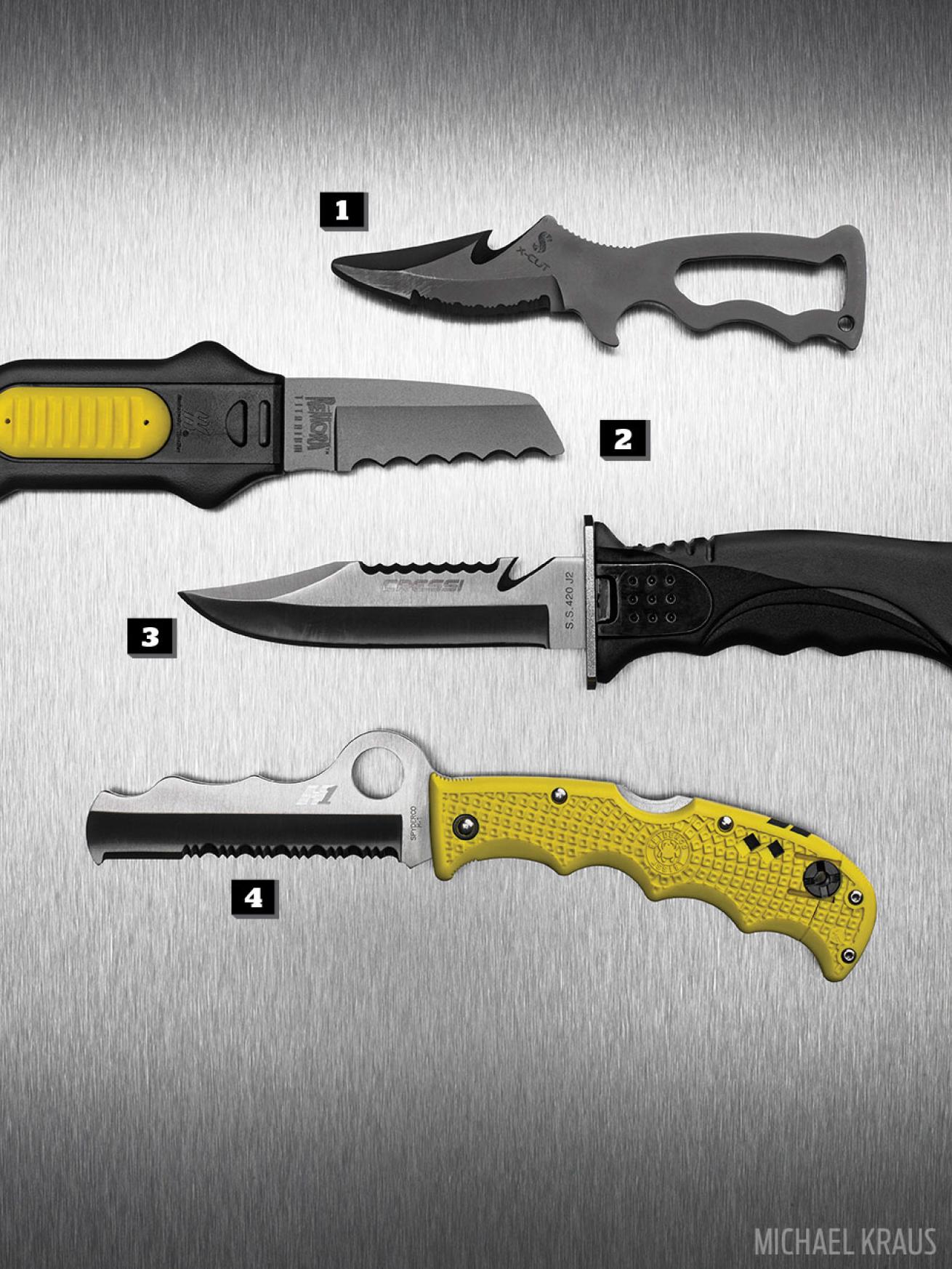
Michael KrausBest Dive Knives of 2015
1. BUY: ScubaPro X-Cutter Titanium
Machined from a single piece of titanium, the little X-Cut is stripped down to the barest essentials of a knife — a blade to cut with and a handle to hold it. We were surprised how easily the blade sliced through every- thing from heavy plastic line to braided nylon — and how it kept its edge through many cuts. The X-Cut was our Testers Choice for compact knives. Contact scubapro.com MSRP $80
2. BUY: UK Remora Titanium Blunt Tip
Stubby and stout, the Remora might look more like a letter opener on steroids than a traditional dive knife, but its 2 1⁄2-inch titanium blade easily ripped through all our test materials. The blade’s back is thick enough to stand lots of abuse, and its blunted tip is angled to allow precise cutting. The Remora was our Testers Choice for BC/ pocket knives. Contact uwkinetics.com MSRP $ 113.99
If you’re looking for an attractively priced knife that can slice or saw through anything and take lots of pounding and prying, your search is over. The beefy Skorpion, nearly 9 1⁄2 inches overall, is built like an anvil, with a thick 420 stainless blade that has straight and serrated edges and a line cutter. The Skorpion earned the Best Buy award in our knife test. Contact cressiusa.com MSRP $39.95
Part of Spyderco’s popular Salt line, this folder is less than 5 inches long when closed. It opens with a flick of the thumb (even while wearing gloves) to expose the serrated/smooth blade with a rounded tip that helps keep the business end away from what you don’t want to cut. The blade cuts effortlessly. It was our Testers Choice in the large-knife category. Contact spyderco.com MSRP $159.95
This past year ScubaLab tested more than 70 pieces of new gear. Here are the regs, BCs, fins, snorkels and knives that excelled.
GEAR OF THE YEAR: REGS
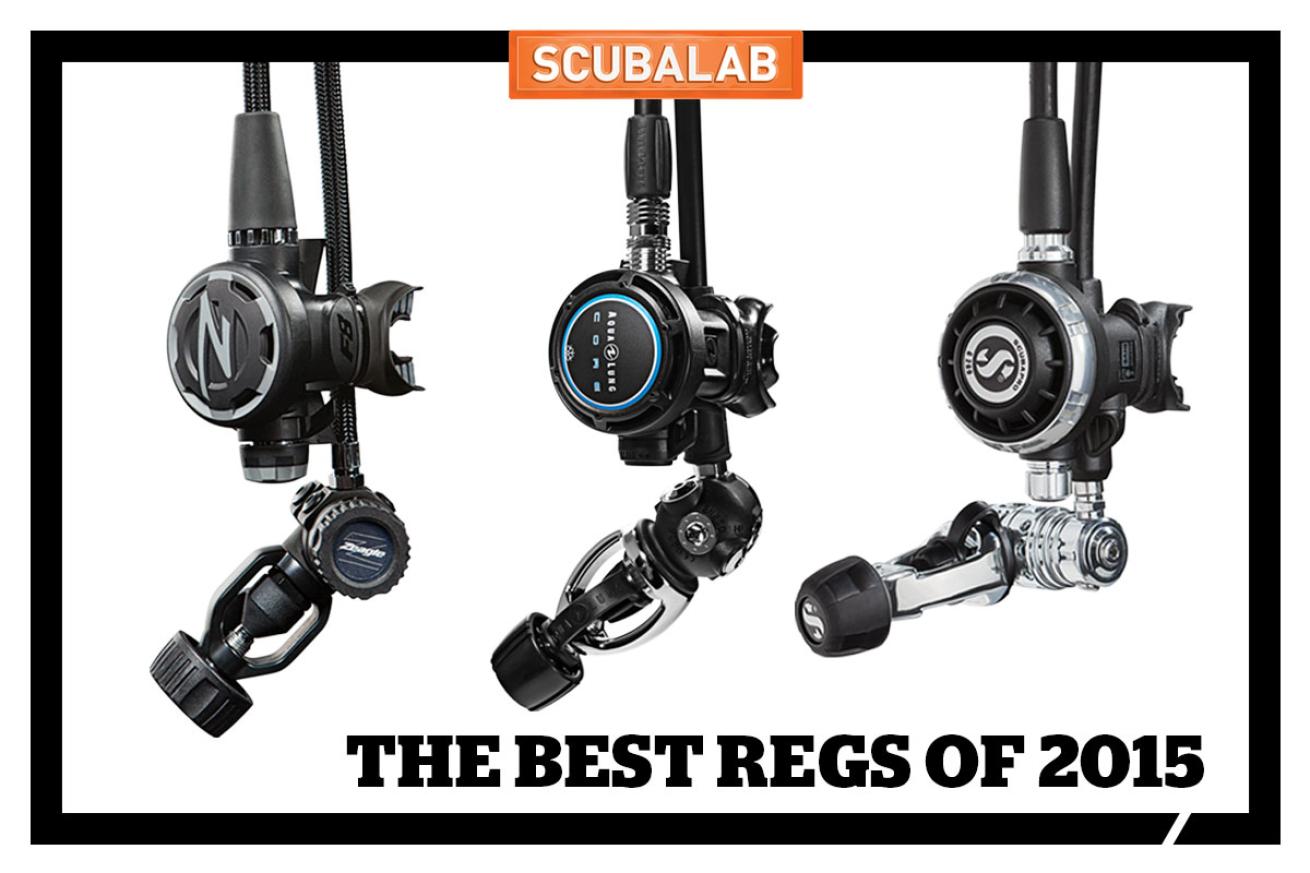
Michael KrausSee full test results at /reg-test-2015
With so many regs to test in 2015, we split up our test, evaluating models under $500 (July) and over $500 (August).
How We Test Regulators
ScubaLab put these regs through two tests — the first is conducted on a breathing simulator (objective), and the second by our team of test divers (ergonomic).
Objective Testing
We conducted tests on an ANSTI wet breathing simulator at Dive Lab, a commercial test facility in Panama City Beach, Florida. The simulator measures the effort (work of breathing) required to move air through a regulator as it is subjected, under- water, to a precise series of depths and breathing rates.
The simulator pressurizes the test chamber to simulate depths of 132 fsw, 165 fsw and 198 fsw. Each “breath” by the machine moves 2.5 liters of air through the regulator, at breathing rates of 15, 25 and 30 breaths a minute. These precisely measured volumes of air — 2.5 liters multiplied by the breathing rate — are called Respiratory Minute Volumes (RMVs).
We don’t test on the simulator for a pass/fail grade, but to objectively gauge performance in carefully controlled conditions. You can see how each reg performed on the breathing simulator in the charts that accompany the reviews.
Ergonomic Test Categories
Ease of breathing in swimming position
Ease of breathing in head-up position
Ease of breathing in head-down position
Wetness in normal swimming position
Wetness in head-down and odd positions
Bubble interference in normal swimming position
Bubble interference in vertical/stationary position
Ease of clearing regulator using the blowing method
Ease of clearing regulator using the purge button
Purge button stiffness and comfort
Comfort of mouthpiece
Venturi lever adjustment function and effectiveness
Breathing- adjustment-knob function and effectiveness
See the Full Test Results Here
GEAR OF THE YEAR: BCs
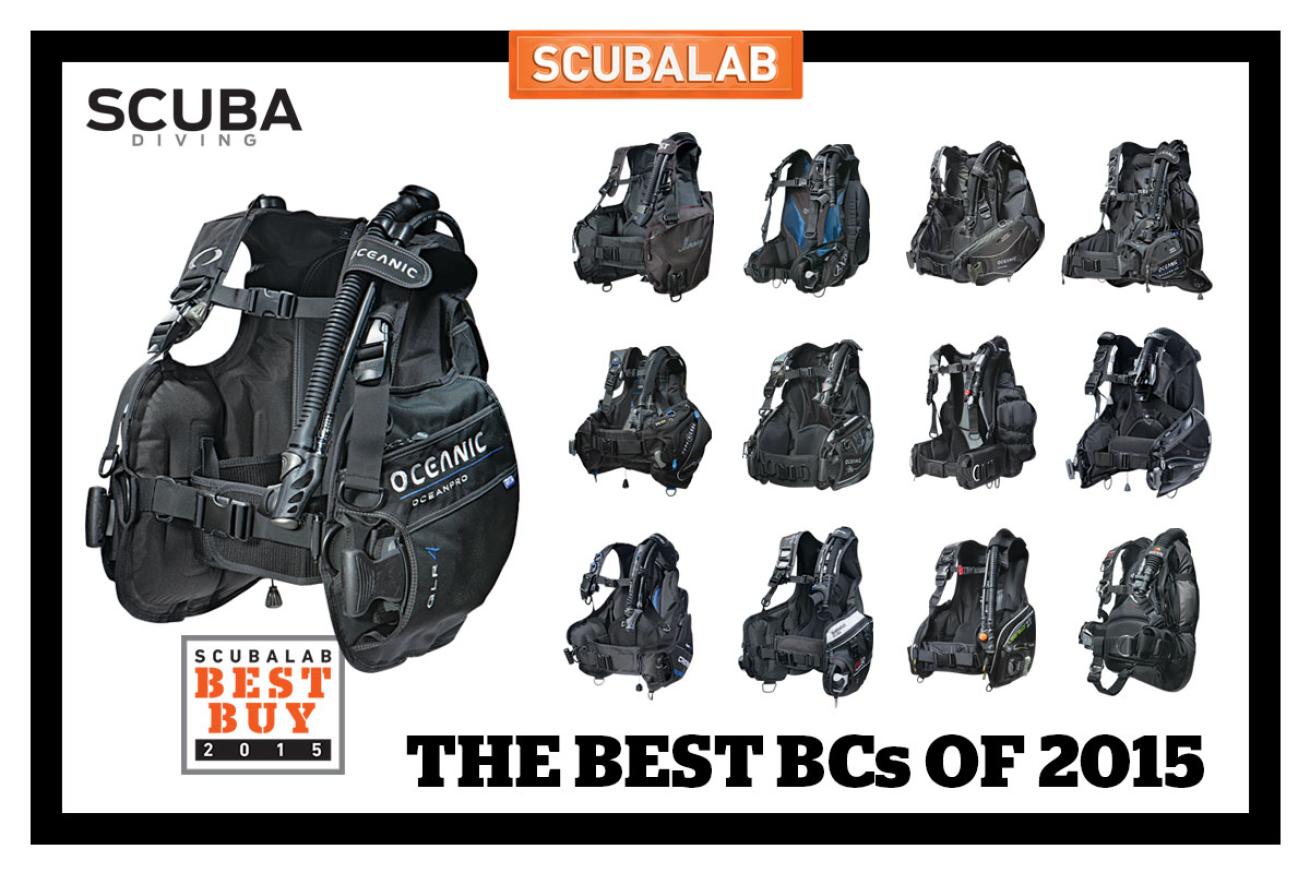
Michael KrausSee full test results at /BC-test
In our June issue we tested 13 new jacket, hybrid and back-inflation BCs for performance, stability and comfort.
How We Test BCs
A ScubaLab BC test has two parts: an in-water ergonomic evaluation by test divers and a series of objective tests we perform in a pool.
Ergonomic Test Categories
Assembly
Loading Weight System
Comfort and Adjustment
Attitude and Stability
Pockets
Valve Operation
Ascent Control
Surface Floating Position
Weight-Ditch System
Objective Tests
Flow-Rate Test
Buoyant Lift Test
Inherent Buoyancy Test
See the Full Test Results Here
GEAR OF THE YEAR: FINS
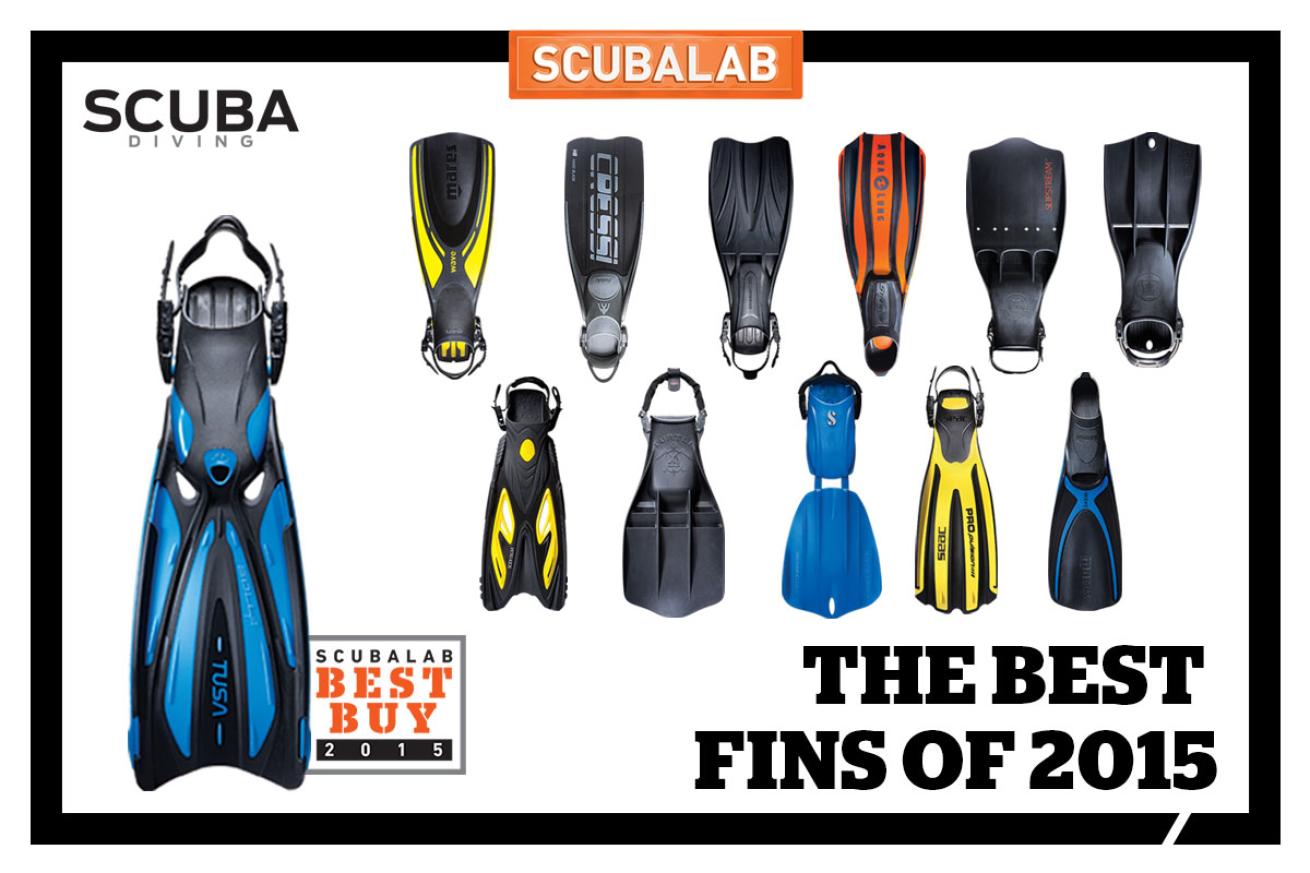
Michael KrausSee full test results at /fin-test-2015
In our May issue we tested 13 new open-heel and full-foot fins in a wide variety of styles and designs.
How We Test Fins
Fins were also evaluated for weight, buoyancy and the effectiveness of non-slip material on the bottom of the sole.
Fin Test Categories
- Ease of Donning Fin
- Adjusting for Fit
- Fit and Comfort
- Stability
- Power vs. Stress
- Kicking Style
- Acceleration
- Maneuverability
- Surface Swimming
- Ease of Removing Fin
See the Full Test Results Here
GEAR OF THE YEAR: SNORKELS
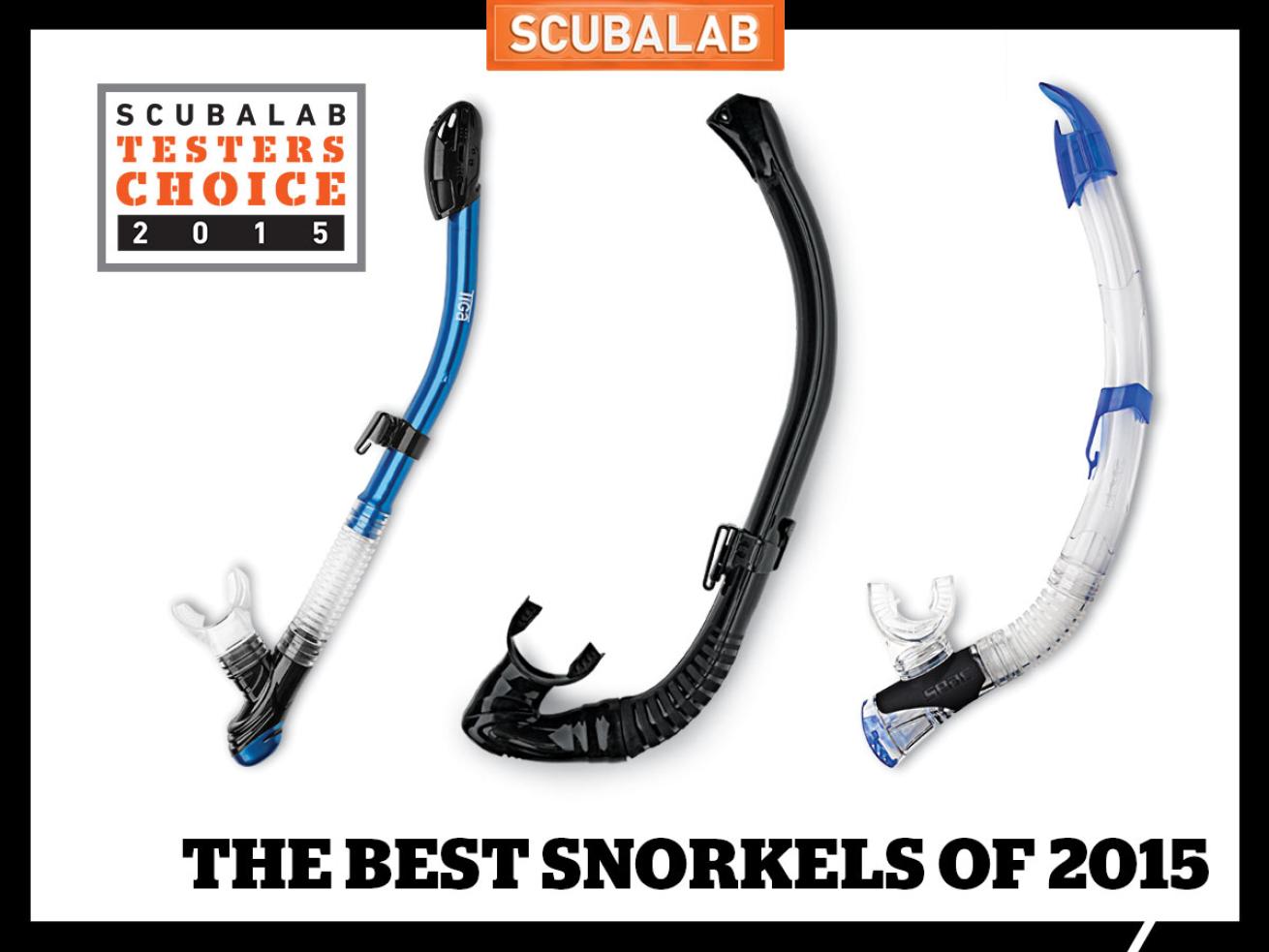
Michael KrausSee full test results at /snorkels-2015
In our September/October issue we tested a dozen snorkels, including pocket models, for performance, comfort and convenience.
How We Test Snorkels
To evaluate the performance of each snorkel in open-water conditions, the ScubaLab team of test divers snorkeled of the beach at Sebastian Inlet State Park on Florida’s Atlantic Coast in seas of about 2 feet, with an onshore breeze of about 12 knots. Using waterproof test sheets and slates, divers rated each snorkel in seven performance categories, with 1 being poor performance and 5 being excellent. Divers also recorded comments about their experience using each snorkel and ranked their top three favorites in each category.
Ergonomic Test Categories
Security, adjustability, convenience and ruggedness of the mask attachment.
Comfort, water seal and position of the mouthpiece.
Effectiveness in blocking water entry.
Effectiveness in removing water by the purge valve or blowing.
Ability to supply sufficient air.
Operating without excessive noise, such as gurgling or rattling.
Weight, dimensions, stability (wobbling) or other factors affecting overall comfort.
See the Full Test Results Here
GEAR OF THE YEAR: KNIVES
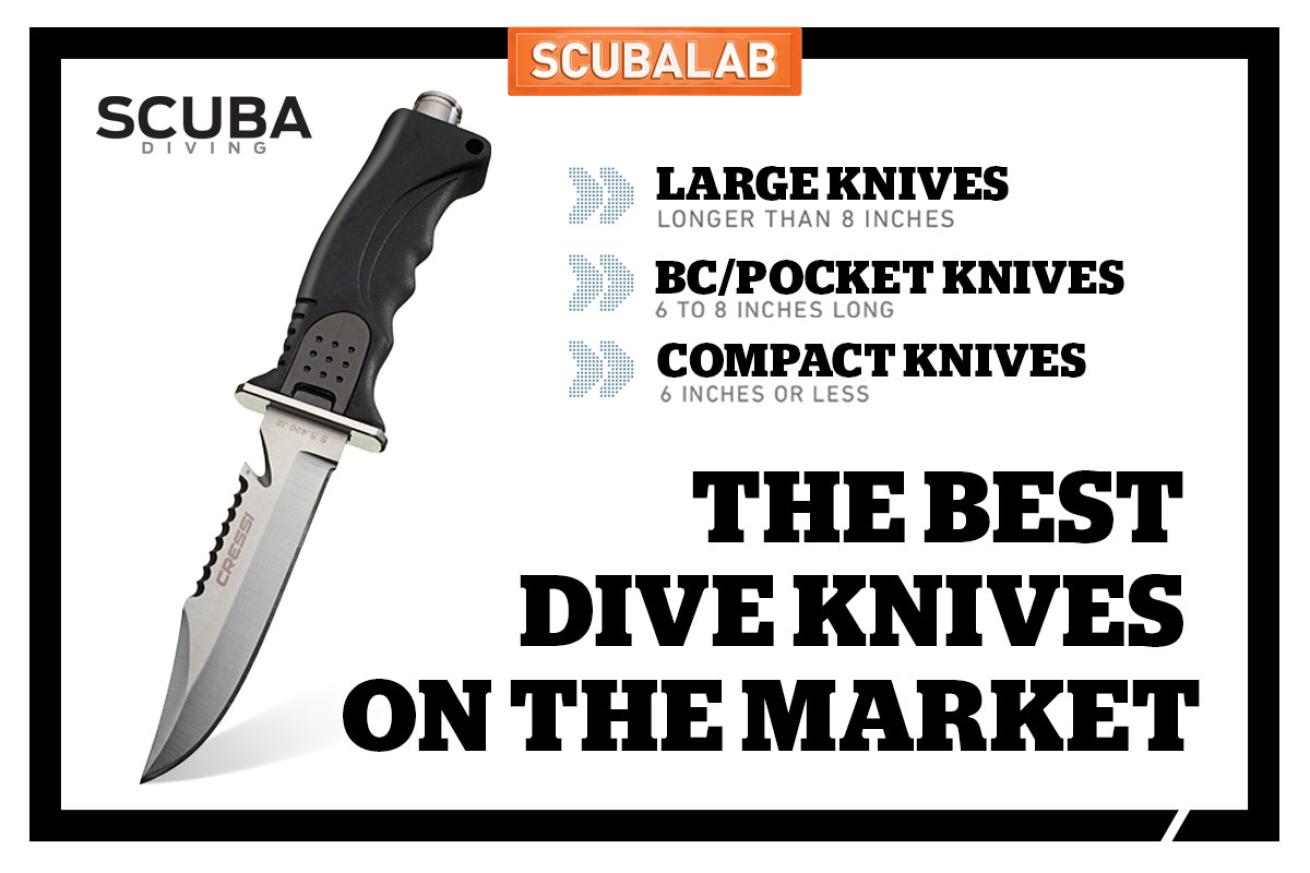
Michael KrausSee full test results at /diveknives
In our March/April issue we tested 22 knives for performance, construction and corrosion resistance.
How We Test Knives
We evaluated each knife’s ability to cut several types of line:
1⁄4-inch diamond braid nylon-poly
1⁄4-inch hollow-braid poly
1⁄2-inch braided nylon
Heavy (.095-inch) plastic trimmer line.
While we could have used tougher lines (such as Kevlar), we chose the lines we did because they’re the kind of cheap, often-discarded, long-lived materials that we encounter diving.
We made a first cut through a hand-held loop of each type of line, and rated the cutting ability from 1 to 5 (1=Poor and 5=Excellent). Next we cut a double thickness of each line, and then we made 20 repetitive cuts of all lines on a block of soft wood, and followed that with more cuts of hand-held loops (since you’re not likely to find a cutting board when diving). We also scored each knife on the following: the security of its sheath or folding/locking mechanism; the ease of deploying/stowing the knife barehanded and with 5 mm gloves; how it withstood 10 pounds of weight when wedged 1-inch deep in a block of wood; and its overall fit and finish.






